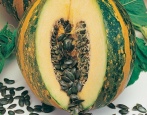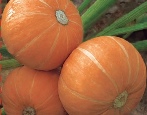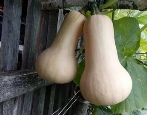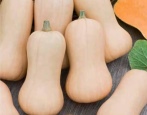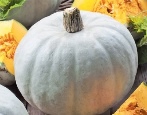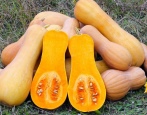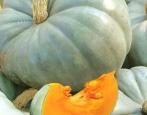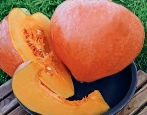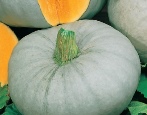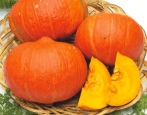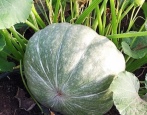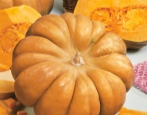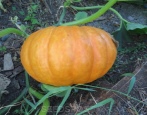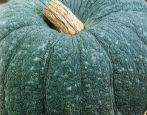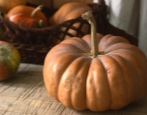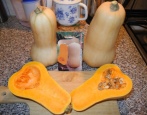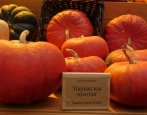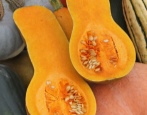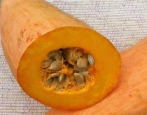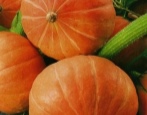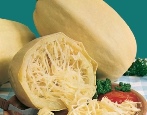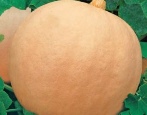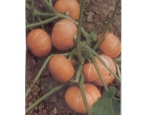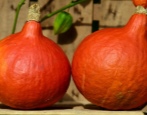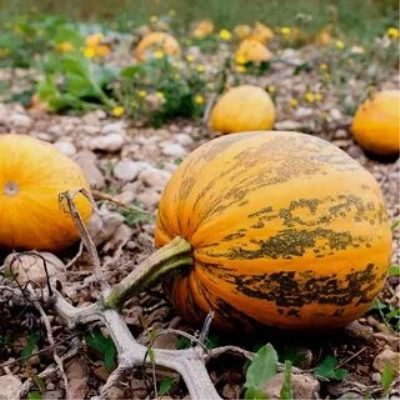
- Year of approval: 1952
- Growth type: medium power
- Lash length, m: until 6
- Leaf shape: pentagonal
- Leaf color: grayish green with fine white spotting along the venation
- Petiole: middle length
- Petiole length, cm : up to 25
- The form: short oval and short cylindrical
- Weight, kg: 4,5-6,8
- Coloration: color of the background of the fruit is dark pink with an orange tint, when fully ripe - brown-brown with a pink tint; pattern - dark green and green mesh, large small rounded and elongated spots, lighter than the main background
Vitamin pumpkin is a popular nutmeg variety, characterized by increased sugar content of the fruit. It is grown in private farmsteads and on farms, and is valued for its excellent yield indicators, the preservation of varietal qualities when collecting seed material. Plants are well protected from diseases and pests, practically do not require effort in the care process.
Breeding history
The variety was bred by FGBNU "FNTS RISA". Included in the State Register of the USSR in 1952.
Description of the variety
Pumpkin Vitamin has good keeping quality. Stored until March under favorable conditions. And also the variety is distinguished by the abundant formation of antennae on the lashes, which, as they grow, are best sprinkled with earth, without removing. Vitamin does not stop its growth on its own, it has to be controlled by the gardeners themselves. The variety is well pollinated without additional effort, in a cross-over manner.
The stems of the Vitamin Pumpkin are creeping, pentahedral in shape. The flowers are large, unisexual, formed separately from each other. The color of the petals is yellow-orange. When harvesting, it is necessary to leave a rather long stalk of about 50 mm on the fruits.
Characteristics of the appearance of plants and fruits
Plants are long-leaved, of medium vigor, with a pubescent central shoot. The main branch is shorter than the lateral ones. The root system is well developed. The leaves are pentagonal, with petioles of medium length, painted in a grayish-green color. On venation, there is a small white spot characteristic of this variety.
The fruits of Vitamin pumpkin are short-cylindrical or short-oval, with ribbing at the stalk, sometimes reaching the middle of the fruit. The bark is thin, leathery, its background color in unripe fruits is dark pink, with an orange tint; in the stage of full ripeness it becomes brown-brown. On the surface, a reticulated dark green pattern can be traced, as well as lighter spots. The pulp is bright orange, almost red, 5-10 cm thick, with large or medium seed nests inside and loose bulky planets.
Purpose and taste
The purpose of the fruit is universal. They are used in processing, consumed fresh, suitable for the preparation of baby food. The pulp of this pumpkin variety contains a lot of carotene. Good taste, with noticeable sweetness in shades. The pulp is crispy, juicy, with a recognizable bright aroma.
Ripening terms
Pumpkin variety Vitaminnaya has a late ripening period. The crop is harvested in August-September, after 124-130 days from the moment of germination.
Yield
Vitamin - pumpkin with high productivity. Average harvests are 36.5-44 t / ha. The weight of each fruit reaches 6-7 kg.
Growing regions
The variety is zoned for cultivation in the North Caucasus region.
Growing and care
Plants are very thermophilic, they need a lot of sunny days for full maturation. They respond well to organic fertilization.They need timely watering at least 1-2 times a week, strictly under the whip. Irrigation is stopped 14 days before the onset of full ripeness. After the first shoots appear, thinning is performed.
The cultivation is carried out by seedling and direct methods. Seeds are sown into the ground from the 3rd decade of May to the beginning of June, with a depth of 3-5 cm and observing a distance of 60x60 cm. When forcing seedlings, the timing changes. Sowing is carried out in April with the sending of seedlings to the ground in May-June.
To protect against pollution, diseases and pests, it is recommended to mulch the soil under the pumpkin seedlings. Backfilling with straw or shavings will help prevent the soil from drying out and make harvesting easier.
Top dressing is carried out according to the schedule, using a solution of manure or chicken droppings 3 weeks after germination. Then, before the ovaries appear, wood ash is added. Organics are given at intervals of 2 weeks. In a cool summer, spraying with a urea solution is additionally required.
When growing Vitamin pumpkin, it is necessary to pinch the central stem at a height of 1.5 m, limiting its growth. 2 lashes are left for each bush. The number of ovaries is also normalized, cutting off the extra ones. Leave no more than 1-2 fruits for the shoot. Some gardeners prefer to hang ripening pumpkins in nets, preventing them from contacting the ground.
Requirements for soil and climatic conditions
The soil needs to be loose, fertile, not too sour, loamy or sandy loam. The beds are prepared high, with a well-fertilized substrate. If the weather is not warm enough, the shoots must be covered with a greenhouse even in June.
Disease and pest resistance
Plants are moderately affected by anthracnose and powdery mildew. With the development of bacteriosis, the bushes are removed, and the area where they were planted is disinfected. Neighboring pumpkins are treated with fungicides.
Review overview
Vitamin is one of those pumpkin varieties that are considered time-tested. Summer residents confidently plant it in a shelter, in a greenhouse or greenhouse, and in the south in open ground, receiving abundant harvests. The seeds give good germination, and the seedlings take root quickly. Vegetable growers also note the rapid formation of lashes, buds and ovaries, prolonged flowering and fruiting.
Like other butternut squash, Vitamin is distinguished by its outstanding taste. In full maturity, its pulp, even fresh, turns out to be truly sugar. And also summer residents use it to make juices and mashed potatoes, dry it, bake it, add it to pies and cereals. This is an excellent variety for food lovers.
This popular variety also has disadvantages. Pumpkins are quite often affected by powdery mildew and various types of rot, and require regular preventive treatment for fungal diseases. The extended ripening period makes this variety poorly suited for cold regions. Without thinning the seedlings, pumpkins turn out to be smaller and weaker, they ripen worse, and are prone to dropping the ovaries.
